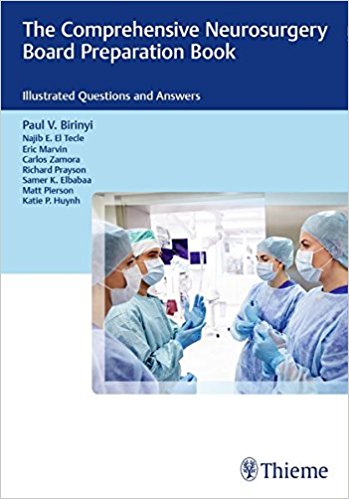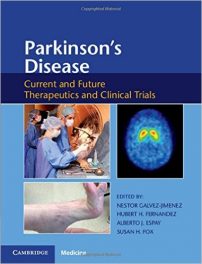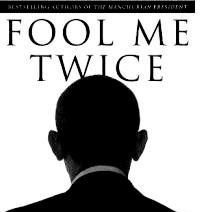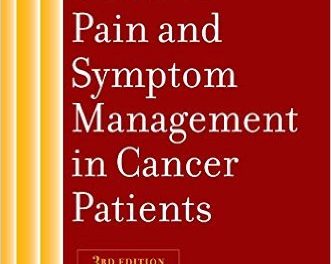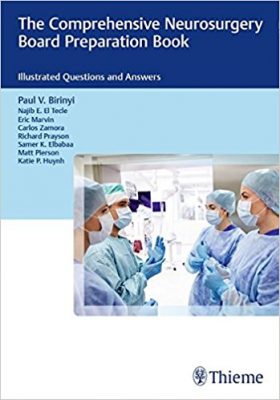 Authors: Paul V, Birinyi, MD; Najib E. El Tecle, MD; Eric Marvin, DO; Carlos Zamora, MD; Richard Prayson, MD; Samer K. Elbabaa, MD; Matt Pierson, MD; and Katie P. Huynh, DO
Authors: Paul V, Birinyi, MD; Najib E. El Tecle, MD; Eric Marvin, DO; Carlos Zamora, MD; Richard Prayson, MD; Samer K. Elbabaa, MD; Matt Pierson, MD; and Katie P. Huynh, DO
Publisher: Thieme – 448 pages
Book Review by: Nano Khilnani
This book provides you sample questions and answers for you to review and test yourself on, to prepare for the primary neurosurgeon’s board exam, a step toward board certification by the American Board of Neurological Surgery (ABNS).
The most complex system of structures in the human body is found in the neurological tract: the brain, spinal cord, and network of peripheral nerves in the limbs. In addition to his general medical knowledge, this is the area – the nervous tract and system – that the neurosurgeon must master. He must have up-close and clear familiarity of the anatomy and physiology of this system. He must also have the variety of skills, dexterity, and decision-making ability to be successful in neurosurgery, writes Dr. Richard D. Bucholz in his Foreword to this book.
The best way to test the knowledge of neurosurgery trainee is by means of a set of questions and answers in a board examination.
As new knowledge comes in, exam review books such as this one are updated. “This new text from Dr. Paul Birinyi and colleagues is an excellent source for review to verify that one’s neurosurgical knowledge is complete and up to date,” writes Dr. Bucholz. He also makes a very important point: “To fully commit to neurosurgery is to commit to a life of education about the nervous system.”
This book has been developed by eight physicians to equip the reader to pass the neurosurgical primary board exam. They write in the Preface that this review book uses the question-and-answer format, presenting more than 1,300 sample questions. It provides color images. It is different from other review texts in that it provides a more accurate representation of the exam, its content, and its style. Brief explanations and pearls accompany each question.
The questions can be studied in a long study session or in smaller doses of shorter time periods. This guide also provides a practice exam that can be taken with the same time limits and breaks as the actual exam. This single resource can help you gain knowledge of the types of questions you will be asked, thereby boosting your confidence that will lead you to a higher score.
We provide below for you an overview of the contents of this exam review book:
- Section I. Questions
- Physiology
- Anatomy
- Adult Neurosurgery
- Pediatric Neurosurgery
- Neurology
- Radiology
- Pathology / Histology
- Ophthalmology
- Critical Care
- Competencies / Health Care / Biostatistics
- Section II. Answers
- Physiology
- Anatomy
- Adult Neurosurgery
- Pediatric Neurosurgery
- Neurology
- Radiology
- Pathology /Histology
- Ophthalmology
- Critical Care
- Competencies / Health Care / Biostatistics
- From the chapter on Physiology with 70 questions, here is sample question 2 with five possible answers:
- What neurotransmitter is used by the preganglionic sympathetic fibers?
- Norepinephrine
- Epinephrine
- Glutamate
- AcetylcholineGABA
- This book is an excellent preparation guide to study for and get a good score on the ABNS primary examination. Written by eight physicians who have “been there, done that,” it is practical and thorough. With good and repeated bouts d of study and practice on the questions and answers, confidence is gained, and the chances of a high score increase. The saying “practice makes perfect” applies here.
- What neurotransmitter is used by the preganglionic sympathetic fibers?
Authors:
Paul V, Birinyi, MD, MS is a resident of neurosurgery at Saint Louis University in St. Louis, Missouri. Originally hailing from the suburbs of Dallas, Texas, he completed his bachelor of arts and master of science degree in cellular and molecular neuroscience at Johns Hopkins University, where he pursued his interests in the genetics of alcohol and drug abuse at the National Institute on Drug Abuse, and in restless leg syndrome at the Johns Hopkins Center for Restless Legs Syndrome.
After returning home from Baltimore, Dr. Birinyi graduated from the University of Texas – Southwestern Medical School in Dallas, Texas, where he engaged extensively in anatomy education. In residency, Dr. Birinyi’s interests include resident education and minimally invasive spine surgery. He currently resides in the St. Louis, Missouri area with his wife Christina and daughter Aubrey.
Najib E. El Tecle, MD, MS is a resident of neurosurgery at Saint Louis University in St. Louis University in St, Louis, Missouri. He completed his medical studies at the Lebanese University in Beirut, Lebanon, before joining Northwestern Memorial Hospital in Chicago, Illinois, for a post-doctoral fellowship in cerebrovascular surgery.
Dr. Tecle’s neurosurgical interests include functional neurosurgery and spine surgery. Dr. Tecle has a special interest in medical device development, and holds a Master of Science degree in biomedical engineering from Northwestern University.
Eric Marvin, DO is an assistant professor of neurosurgery at Virginia Tech Carillon School of Medicine, and an assistant professor of neurosurgery at Virginia College of Osteopathic Medicine in Roanoke, Virginia. He received his medical degree from Lake Erie College of Osteopathic Medicine, and completed his neurosurgery residency at Virginia College of Osteopathic Medicine. His cerebrovascular and skull base fellowship was at Saint Louis University.
Carlos Zamora, MD, PhD is an assistant professor of radiology at the University of North Carolina School of Medicine in Chapel Hill, North Carolina. He received his medical degree from the Universidad de San Carlos in Guatemala, and subsequently obtained a PhD in medical sciences from Kobe University in Japan.
After a medical internship in New York, New York, he completed his residency in diagnostic radiology and a two-year fellowship in neuro-radiology at Johns Hopkins Hospital in Baltimore, Maryland, where he also worked as a clinical instructor. Dr. Zamora is board certified in diagnostic radiology with an interest in all aspects of neuro-radiology education including brain, head and neck, and spine, with a particular interest in skull base pathology.
Richard Prayson, MD, Med is the section head of the Cleveland Clinic and director of student affairs at the Cleveland Clinic Lerner College of Medicine in Cleveland, Ohio.
Samer K. Elbabaa, MD, FANS, FACS is the Reinert Endowed Chair in Pediatric Neurosurgery, associate professor of neurosurgery, and director of pediatric neurosurgery at Saint Louis University School of Medicine. He completed his internship and residency in neurological surgery at the University of North Carolina at Chapel Hill. He also completed a clinical fellowship in pediatric neurosurgery at the Cleveland Clinic. He is board certified by the American Board of Neurological Surgery.
His clinical and research areas of interest include pediatric neurosurgery, brain and spinal cord tumors, skull base surgery, microneurosurgery, neuroendoscopy, fetal spina bifida surgery, craniocervical junction anomalies, craniofacial surgery, and neurosurgical education.
Matt Pierson, MD is a resident of neurosurgery at Saint Louis University in St. Louis, Missouri.
Katie P. Huynh, DO is a neurosurgeon in Coeur d’Alene, Idaho. Her fellowship is in cerebrovascular and skull base neurosurgery at Saint Louis University in St. Louis, Missouri. Dr. Huynh received her medical degree from the Western University of Health Sciences, and completed her neurological surgery residency at Arrowhead Regional Medical Center, both in Southern California. She loves spending time outdoors with her husband Adam and three daughters Kaitlin, Kara, Isabella.

